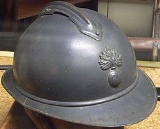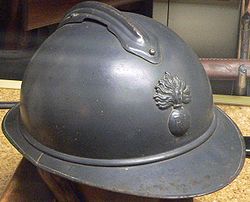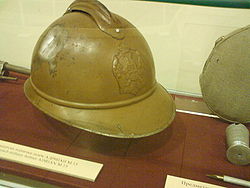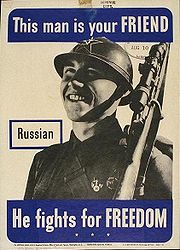
Adrian helmet
Encyclopedia
The M15 Adrian helmet was a combat helmet
issued to the French Army
during World War I
. It was the first standard helmet of the French Army and was designed when millions of French
troops were engaged in trench warfare
, and head wounds became a frequent cause of battlefield casualties. Introduced in 1915, it was the first modern steel helmet and it served as the basic helmet of many armies well into the 1930s. Initially issued to infantry soldiers, in modified form they were also issued to cavalry and tank crews. A subsequent version, the M26, was used during World War II
.

 At the outbreak of World War I
At the outbreak of World War I
soldiers in the French army wore the standard kepi
cap, which provided no protection against injury. The early stages of trench warfare
proved that even basic protection of the head would result in a significantly smaller mortality rate among front-line soldiers. Consequently, the French staff ordered development of a metal helmet that could protect soldiers from the shrapnel of exploding artillery
shell
s. Since soldiers in trenches were also vulnerable to shrapnel exploding above their heads, a deflector crest was added along the helmet's axis. Contrary to common misconception, the M15 helmet was not designed to protect the wearer from direct impact by rifle
or machine gun
bullet
s. The resulting headgear was credited to Intendant-General August-Louis Adrian.
 The helmet adopted by the army was made of mild steel and weighed only 0.765 kg (1 lb.11oz.), which made it lighter than the contemporary British
The helmet adopted by the army was made of mild steel and weighed only 0.765 kg (1 lb.11oz.), which made it lighter than the contemporary British
Brodie helmet
and the German
Stahlhelm
, although it also delivered less protection against shrapnel and bullets. By the end of World War I
, it had been issued to almost all infantry units fighting with the French army. It was also used by some of the American divisions fighting in France. and the Polish
forces of Haller's
Blue Army
.
The helmet proved to be fairly efficient against shrapnel, cheap, and easy to manufacture. As a consequence, more than three million Adrian helmets were produced, and they were widely adopted by other countries including Belgium
, Brazil
, China
, Greece
, Italy
(including license-built versions), Japan
, Luxembourg
, Mexico
, Morocco
, Peru
, Poland
, Romania
, Russia
, Serbia
, Siam
, U.S.A.
, U.S.S.R.
, and Yugoslavia
. Each of these nations added its own insignia to the front of the helmet. (The Irish Defense Forces tested the Adrian in 1928 but never adopted it.)
Because the new steel helmets offered little actual protection against bullets, some were reportedly among the first pieces of equipment being abandoned by the soldiers on the battlefield. It was also discovered that the badge placed on the front of helmets impaired the helmet's durability, which made several armies remove their national insignia altogether. Early helmets were painted blue for French troops and khaki for colonial forces. Those made after 1935 are usually khaki, reflecting the French army moves to a more camouflaged uniform in the 1930s.
In 1926 the Adrian helmet was modified by being constructed of stronger steel and simplified by having the main part of the helmet stamped from one piece of metal, and therefore without the joining rim around the helmet that characterizes the M15. The large ventilation hole under the comb, which had been a weak point of the old design, was also replaced with a series of small holes. The M26 helmet continued in use with the French army until after World War II
, and was also used by the French police up to the 1970s. In other countries the Adrian-type helmets were also in use with the fire-fighting units, railway guards or marine infantry. Adrian helmets are still prized by collectors today.
Combat helmet
A combat helmet or battle helmet is a type of personal armor designed specifically to protect the head during combat. Helmets are among the oldest forms of personal protective equipment and are known to have been worn by the Akkadians/Sumerians in the 23rd century BC, Mycenaean Greeks since 17th...
issued to the French Army
French Army
The French Army, officially the Armée de Terre , is the land-based and largest component of the French Armed Forces.As of 2010, the army employs 123,100 regulars, 18,350 part-time reservists and 7,700 Legionnaires. All soldiers are professionals, following the suspension of conscription, voted in...
during World War I
World War I
World War I , which was predominantly called the World War or the Great War from its occurrence until 1939, and the First World War or World War I thereafter, was a major war centred in Europe that began on 28 July 1914 and lasted until 11 November 1918...
. It was the first standard helmet of the French Army and was designed when millions of French
France
The French Republic , The French Republic , The French Republic , (commonly known as France , is a unitary semi-presidential republic in Western Europe with several overseas territories and islands located on other continents and in the Indian, Pacific, and Atlantic oceans. Metropolitan France...
troops were engaged in trench warfare
Trench warfare
Trench warfare is a form of occupied fighting lines, consisting largely of trenches, in which troops are largely immune to the enemy's small arms fire and are substantially sheltered from artillery...
, and head wounds became a frequent cause of battlefield casualties. Introduced in 1915, it was the first modern steel helmet and it served as the basic helmet of many armies well into the 1930s. Initially issued to infantry soldiers, in modified form they were also issued to cavalry and tank crews. A subsequent version, the M26, was used during World War II
World War II
World War II, or the Second World War , was a global conflict lasting from 1939 to 1945, involving most of the world's nations—including all of the great powers—eventually forming two opposing military alliances: the Allies and the Axis...
.
History and usage


World War I
World War I , which was predominantly called the World War or the Great War from its occurrence until 1939, and the First World War or World War I thereafter, was a major war centred in Europe that began on 28 July 1914 and lasted until 11 November 1918...
soldiers in the French army wore the standard kepi
Kepi
The kepi is a cap with a flat circular top and a visor or peak . Etymologically, the word is a borrowing of the French képi, itself a respelling of the Alemannic Käppi: a diminutive form of Kappe, meaning "cap"....
cap, which provided no protection against injury. The early stages of trench warfare
Trench warfare
Trench warfare is a form of occupied fighting lines, consisting largely of trenches, in which troops are largely immune to the enemy's small arms fire and are substantially sheltered from artillery...
proved that even basic protection of the head would result in a significantly smaller mortality rate among front-line soldiers. Consequently, the French staff ordered development of a metal helmet that could protect soldiers from the shrapnel of exploding artillery
Artillery
Originally applied to any group of infantry primarily armed with projectile weapons, artillery has over time become limited in meaning to refer only to those engines of war that operate by projection of munitions far beyond the range of effect of personal weapons...
shell
Shell (projectile)
A shell is a payload-carrying projectile, which, as opposed to shot, contains an explosive or other filling, though modern usage sometimes includes large solid projectiles properly termed shot . Solid shot may contain a pyrotechnic compound if a tracer or spotting charge is used...
s. Since soldiers in trenches were also vulnerable to shrapnel exploding above their heads, a deflector crest was added along the helmet's axis. Contrary to common misconception, the M15 helmet was not designed to protect the wearer from direct impact by rifle
Rifle
A rifle is a firearm designed to be fired from the shoulder, with a barrel that has a helical groove or pattern of grooves cut into the barrel walls. The raised areas of the rifling are called "lands," which make contact with the projectile , imparting spin around an axis corresponding to the...
or machine gun
Machine gun
A machine gun is a fully automatic mounted or portable firearm, usually designed to fire rounds in quick succession from an ammunition belt or large-capacity magazine, typically at a rate of several hundred rounds per minute....
bullet
Bullet
A bullet is a projectile propelled by a firearm, sling, or air gun. Bullets do not normally contain explosives, but damage the intended target by impact and penetration...
s. The resulting headgear was credited to Intendant-General August-Louis Adrian.

United Kingdom of Great Britain and Ireland
The United Kingdom of Great Britain and Ireland was the formal name of the United Kingdom during the period when what is now the Republic of Ireland formed a part of it....
Brodie helmet
Brodie helmet
The Brodie helmet, called Helmet, steel, Mark I helmet in Britain and the M1917 Helmet in the U.S., was a steel combat helmet designed and patented in 1915 by the Briton John Leopold Brodie...
and the German
German Empire
The German Empire refers to Germany during the "Second Reich" period from the unification of Germany and proclamation of Wilhelm I as German Emperor on 18 January 1871, to 1918, when it became a federal republic after defeat in World War I and the abdication of the Emperor, Wilhelm II.The German...
Stahlhelm
Stahlhelm
Stahlhelm is German for "steel helmet". The Imperial German Army began to replace the traditional boiled-leather Pickelhaube with the Stahlhelm during World War I in 1916...
, although it also delivered less protection against shrapnel and bullets. By the end of World War I
World War I
World War I , which was predominantly called the World War or the Great War from its occurrence until 1939, and the First World War or World War I thereafter, was a major war centred in Europe that began on 28 July 1914 and lasted until 11 November 1918...
, it had been issued to almost all infantry units fighting with the French army. It was also used by some of the American divisions fighting in France. and the Polish
Poland
Poland , officially the Republic of Poland , is a country in Central Europe bordered by Germany to the west; the Czech Republic and Slovakia to the south; Ukraine, Belarus and Lithuania to the east; and the Baltic Sea and Kaliningrad Oblast, a Russian exclave, to the north...
forces of Haller's
Józef Haller de Hallenburg
Józef Haller de Hallenburg was a Lieutenant General of the Polish Army, legionary in Polish Legions, harcmistrz , the President of The Polish Scouting and Guiding Association , political and social activist, Stanisław Haller de Hallenburg's cousin.Haller was born in Jurczyce...
Blue Army
Blue Army
The Blue Army, or Haller's Army, are informal names given to the Polish Army units formed in France during the later stages of World War I. The army was created in June 1917 as part of the Polish units allied to the Entente. After the Great War ended, the units were transferred to Poland, where...
.
The helmet proved to be fairly efficient against shrapnel, cheap, and easy to manufacture. As a consequence, more than three million Adrian helmets were produced, and they were widely adopted by other countries including Belgium
Belgium
Belgium , officially the Kingdom of Belgium, is a federal state in Western Europe. It is a founding member of the European Union and hosts the EU's headquarters, and those of several other major international organisations such as NATO.Belgium is also a member of, or affiliated to, many...
, Brazil
Brazil
Brazil , officially the Federative Republic of Brazil , is the largest country in South America. It is the world's fifth largest country, both by geographical area and by population with over 192 million people...
, China
Republic of China
The Republic of China , commonly known as Taiwan , is a unitary sovereign state located in East Asia. Originally based in mainland China, the Republic of China currently governs the island of Taiwan , which forms over 99% of its current territory, as well as Penghu, Kinmen, Matsu and other minor...
, Greece
Greece
Greece , officially the Hellenic Republic , and historically Hellas or the Republic of Greece in English, is a country in southeastern Europe....
, Italy
Italy
Italy , officially the Italian Republic languages]] under the European Charter for Regional or Minority Languages. In each of these, Italy's official name is as follows:;;;;;;;;), is a unitary parliamentary republic in South-Central Europe. To the north it borders France, Switzerland, Austria and...
(including license-built versions), Japan
Japan
Japan is an island nation in East Asia. Located in the Pacific Ocean, it lies to the east of the Sea of Japan, China, North Korea, South Korea and Russia, stretching from the Sea of Okhotsk in the north to the East China Sea and Taiwan in the south...
, Luxembourg
Luxembourg
Luxembourg , officially the Grand Duchy of Luxembourg , is a landlocked country in western Europe, bordered by Belgium, France, and Germany. It has two principal regions: the Oesling in the North as part of the Ardennes massif, and the Gutland in the south...
, Mexico
Mexico
The United Mexican States , commonly known as Mexico , is a federal constitutional republic in North America. It is bordered on the north by the United States; on the south and west by the Pacific Ocean; on the southeast by Guatemala, Belize, and the Caribbean Sea; and on the east by the Gulf of...
, Morocco
Morocco
Morocco , officially the Kingdom of Morocco , is a country located in North Africa. It has a population of more than 32 million and an area of 710,850 km², and also primarily administers the disputed region of the Western Sahara...
, Peru
Peru
Peru , officially the Republic of Peru , is a country in western South America. It is bordered on the north by Ecuador and Colombia, on the east by Brazil, on the southeast by Bolivia, on the south by Chile, and on the west by the Pacific Ocean....
, Poland
Poland
Poland , officially the Republic of Poland , is a country in Central Europe bordered by Germany to the west; the Czech Republic and Slovakia to the south; Ukraine, Belarus and Lithuania to the east; and the Baltic Sea and Kaliningrad Oblast, a Russian exclave, to the north...
, Romania
Romania
Romania is a country located at the crossroads of Central and Southeastern Europe, on the Lower Danube, within and outside the Carpathian arch, bordering on the Black Sea...
, Russia
Russia
Russia or , officially known as both Russia and the Russian Federation , is a country in northern Eurasia. It is a federal semi-presidential republic, comprising 83 federal subjects...
, Serbia
Serbia
Serbia , officially the Republic of Serbia , is a landlocked country located at the crossroads of Central and Southeast Europe, covering the southern part of the Carpathian basin and the central part of the Balkans...
, Siam
Thailand
Thailand , officially the Kingdom of Thailand , formerly known as Siam , is a country located at the centre of the Indochina peninsula and Southeast Asia. It is bordered to the north by Burma and Laos, to the east by Laos and Cambodia, to the south by the Gulf of Thailand and Malaysia, and to the...
, U.S.A.
United States
The United States of America is a federal constitutional republic comprising fifty states and a federal district...
, U.S.S.R.
Russian Soviet Federative Socialist Republic
The Russian Soviet Federative Socialist Republic , commonly referred to as Soviet Russia, Bolshevik Russia, or simply Russia, was the largest, most populous and economically developed republic in the former Soviet Union....
, and Yugoslavia
Yugoslavia
Yugoslavia refers to three political entities that existed successively on the western part of the Balkans during most of the 20th century....
. Each of these nations added its own insignia to the front of the helmet. (The Irish Defense Forces tested the Adrian in 1928 but never adopted it.)
Because the new steel helmets offered little actual protection against bullets, some were reportedly among the first pieces of equipment being abandoned by the soldiers on the battlefield. It was also discovered that the badge placed on the front of helmets impaired the helmet's durability, which made several armies remove their national insignia altogether. Early helmets were painted blue for French troops and khaki for colonial forces. Those made after 1935 are usually khaki, reflecting the French army moves to a more camouflaged uniform in the 1930s.
In 1926 the Adrian helmet was modified by being constructed of stronger steel and simplified by having the main part of the helmet stamped from one piece of metal, and therefore without the joining rim around the helmet that characterizes the M15. The large ventilation hole under the comb, which had been a weak point of the old design, was also replaced with a series of small holes. The M26 helmet continued in use with the French army until after World War II
World War II
World War II, or the Second World War , was a global conflict lasting from 1939 to 1945, involving most of the world's nations—including all of the great powers—eventually forming two opposing military alliances: the Allies and the Axis...
, and was also used by the French police up to the 1970s. In other countries the Adrian-type helmets were also in use with the fire-fighting units, railway guards or marine infantry. Adrian helmets are still prized by collectors today.
Trivia
- The Soviet model with a large red star became a classic symbol of front-line soldiers of the U.S.S.R. (see poster).
- The Adrian helmet was also worn and preferred by British Prime Minister Winston ChurchillWinston ChurchillSir Winston Leonard Spencer-Churchill, was a predominantly Conservative British politician and statesman known for his leadership of the United Kingdom during the Second World War. He is widely regarded as one of the greatest wartime leaders of the century and served as Prime Minister twice...
(along with the pith helmetPith helmetThe pith helmet is a lightweight cloth-covered helmet made of cork or pith...
) during his visits to the battlefield during World War IIWorld War IIWorld War II, or the Second World War , was a global conflict lasting from 1939 to 1945, involving most of the world's nations—including all of the great powers—eventually forming two opposing military alliances: the Allies and the Axis...
. - The shoulder patchShoulder patchA shoulder sleeve insignia, is an embroidered patch used by major formations of the United States Army. Each formation has a unique formation patch, and the US Army is unique among the US armed services in that all soldiers are required to wear the patch of their headquarters as part of their...
of the U.S. 93rd Infantry Division features the Adrian helmet.
- Polish cavalryPolish cavalryThe Polish cavalry can trace its origins back to the days of Medieval mounted knights. Poland had always been a country of flatlands and fields and mounted forces operate well in this environment...
units refused to wear other kinds of helmets, because they were so attached to the appearance of the "Adrian".

